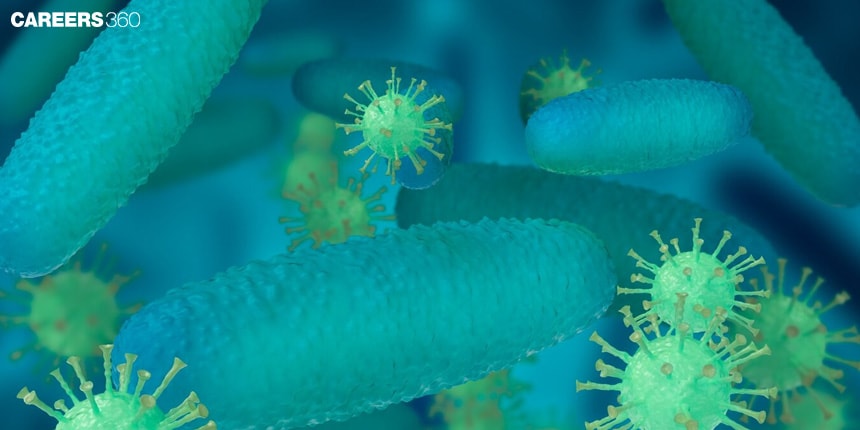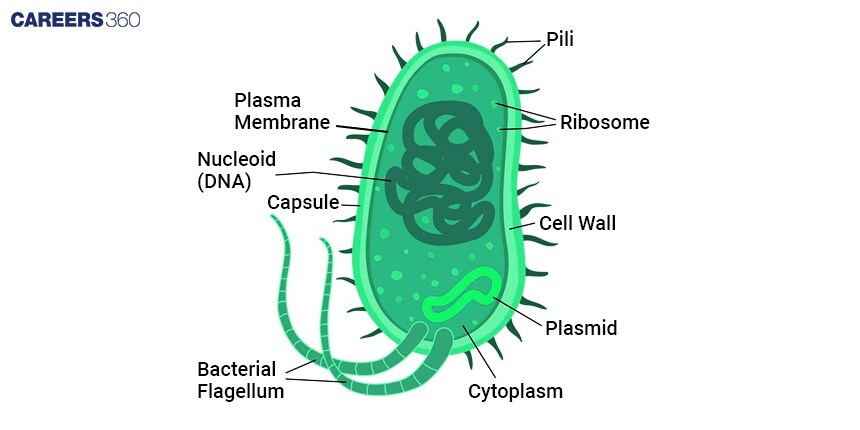Monera: Definition, Classification, Characteristics, Structure, Examples
Definition of Monera: The Monera is a unicellular prokaryotic organism comprising, but mainly consisting of, bacteria and archaea. If viewed using a microscope, it seems to have no true nucleus, unlike other membrane-bound organelles. The organisms of Kingdom Monerans divide through binary fission and can live in various environments, from soil and water to extreme conditions. Monera is a topic in the chapter Biological Classification in Biology.
NEET 2025: Mock Test Series | Syllabus | High Scoring Topics | PYQs
NEET Important PYQ's Subject wise: Physics | Chemistry | Biology
New: Meet Careers360 B.Tech/NEET Experts in your City | Book your Seat now
- What is Kingdom Monera?
- Kingdom Monera Characteristics
- Classification of Monera
- Bacteria: A Major Group in Monera
- Role of Bacteria in the Environment
- Economic Importance
- Archaea: Unique Prokaryotes
- Symbiotic Relationships
- Pathogenic Bacteria
- Laboratory Techniques for Studying Monera
- Modern Applications of Monera
- Recommended Video on Monera:

What is Kingdom Monera?
The five kingdoms of biological classification include Monera. It comprises unicellular and prokaryotic organisms. They can be either unicellular or multicellular. These are organisms with no true nuclei or membrane-bound organelles, a characteristic that demarcates them from the eukaryotic cells. Monera has a wide range of diversity in terms of shape and metabolic types. Since monera are found in almost all environments, they range from deep oceans to extreme hot springs.
The significance of studying the Monera organisms is that these microbes play very important roles almost in all ecological and biological operations that range from nutrient cycling, and decomposition to nitrogen fixation. They are, additionally, with high importance in medicine, agriculture, and industry whereby it spans antibiotic production to genetic engineering. They also offer knowledge helpful for the control of infectious diseases and new biotechnological developments.
Kingdom Monera Characteristics
The characteristics of monera are defined as:
Cell Structure
Lack of a true membrane-bound nucleus and membrane-bound organelles.
Cell wall composition is mostly of peptidoglycan.
There is no nuclear membrane that encapsulates the genetic material.
However, protein synthesis occurs in these ribosomes, which turn out to be smaller as compared to those of the eukaryotes.
Involvement of the plasma membranes with mesosomes in cellular processes such as respiration and replication of DNA.
Genetic Material
Circular DNA molecule located within the nucleoid region, not membrane-bounded.
Small, circular pieces of DNA that are called plasmids replicate independently of the chromosomal DNA. Often these carry genes for antibiotic resistance and other functions.
Metabolism
The metabolism includes:
Autotrophic
Use sunlight to synthesise food, e.g., cyanobacteria.
Use chemical reactions to obtain energy, e.g., nitrifying bacteria.
Heterotrophic
Decompose and absorb nutrients from dead organic matter.
Obtain nutrients from living hosts, often causing disease.
Also read-
Classification of Monera
Monerans are classified based on various characteristics:
Based On Shape
Cocci: Spherical-shaped bacteria.
Bacilli: Rod-shaped bacteria.
Spirilla: Spiral or corkscrew-shaped bacteria.
Vibrios: Comma-shaped bacteria.
Based On Gram Staining
Gram-positive
Gram-negative
Based On Nutrition
Based on nutrition monera are classified as:
Autotrophs
Synthesise their food from inorganic substances.
Heterotrophs
Obtain their food from organic substances.
Based On Respiration
Based on the mode of respiration monera are classified as:
Aerobic
Require oxygen for respiration.
Anaerobic
Do not require oxygen for respiration and may even be poisoned by it.
Based On Reproduction
The different modes of reproduction are:
Binary fission
A process of asexual reproduction in which the cell just divides into two identical daughter cells.
Budding
A type of asexual reproduction in which a new organism develops from an outgrowth or bud due to cell division at one specific site.
Endospore formation
A survival mechanism in which the bacterium produces a tough resistant spore in which to withstand unfavourable conditions.
Bacteria: A Major Group in Monera
The different types and examples of bacteria are classified as:
Archaebacteria
Methanogens: These microbes produce methane as a byproduct of their anaerobic respiration.
Halophiles: are found in extreme, high-salt environments like salt lakes and salt marshes.
Thermoacidophiles: Opt for extremely high temperatures and acidity environments, as in the case of hot springs and volcanic vents.
Eubacteria
Cyanobacteria are Photosynthetic bacteria that release oxygen as a photosynthetic by-product.
Actinobacteria are filamentous. Ecologically important in decomposition.
Bacteria Diagram
The diagram given below shows the bacterial cell and its components

Role of Bacteria in the Environment
Convert atmospheric nitrogen to ammonia, which can be used by plants.
Break organic matter into simple compounds, hence this recycles nutrients.
Use bacteria in the biodegradation of pollutants, hence these purify polluted environments through natural means.
Economic Importance
Bacteria are used in the production of antibiotics such as penicillin and streptomycin. These are used in the treatment of bacterial infections in humans and domestic animals.
They supply enzymes, vitamins, and other biochemicals that are used internally in industries.
Bacteria in agriculture mainly aid in nitrogen fixation, in which atmospheric nitrogen is converted into forms available for the plants to grow on.
Some bacteria-for instance, plant growth produce growth-promoting substances and protect plants from pathogens; they therefore promote the growth of plants.
The process is very important in fermentation because bacteria, here, convert sugars into alcohol, acids, or gases.
This therefore aids in the production of food products such as yoghurt, cheese, vinegar, and bread.
They also improve the flavour and texture as well as the nutritional value of the food.
Archaea: Unique Prokaryotes
They are the extremophiles theoretically known to grow at high temperatures, high salt concentrations, and acidic or alkaline conditions.
Differences from Eubacteria
Archaea possess unique cell-membrane lipids which are distinct from true bacteria.
The molecular machinery of transcription and translation is more akin to the eukaryotes than the eubacteria.
Unlike eubacteria that contain peptidoglycan, archaea do not have peptidoglycan in their cell walls.
Symbiotic Relationships
The symbiotic relationships exhibited by bacteria are:
Rhizobium in nitrogen fixation
Forms symbiotic relationships with leguminous plants; for instance peas and beans.
Fixes nitrogen from the air into ammonia, used by the plant to grow. The plant provides carbon and shelter to the bacteria.
Gut Bacteria in Humans and Ruminants
Play an important role in the digestion of the host by degrading complex carbohydrates that the host is not able to carry out itself
The microbes also synthesize vitamins and other compounds useful to the nutrition and good health of the host.
Biofilms
Biofilms are communities of bacteria that they attach to through a self-produced extracellular polymeric substance EPS matrix.
They develop on surfaces such as rocks, medical implants, and teeth, creating either beneficial as in wastewater treatment or detrimental for example dental plaques.
Biofilms provide a very high degree of protection from antibiotics and immunological responses hence increased survival in hostile environments
Pathogenic Bacteria
Pathogenic bacteria cause several diseases in humans, which influence public health.
Tuberculosis: This is caused by Mycobacterium tuberculosis. It mainly attacks the lungs. spots The general symptoms are chronic coughing, fever, and loss of weight.
Cholera: This is caused by Vibrio cholerae. There is acute diarrhoea and dehydration that will lead to death unless treated.
Typhoid: It is caused by Salmonella typhi.
Pneumonia: Many cases are due to Streptococcus pneumoniae.
Plant diseases: Plant diseases caused by pathogenic bacteria cause massive destruction to crops amounting to heavy agriculture losses.
The excessive epidemic of bacterial blight in crops such as rice and beans, for instance, is one that massively impairs food production through symptoms such as wilting and leaf spots that lead to reduced yield.
Laboratory Techniques for Studying Monera
The laboratory techniques are described below:
Gram staining
Differentiates bacteria into Gram-positive (purple) and Gram-negative (pink) based on cell wall properties.
Acid-fast staining
Identifies acid-fast bacteria, such as Mycobacterium species, which retain the stain even after being washed with acidic alcohol.
Agar plates
The solid medium used to grow and isolate pure bacterial colonies.
Broth cultures
This is the liquid media suspension to grow bacteria. This gives large amounts of bacterial growth.
Light microscopy
The shape, size, and arrangement of bacteria are viewed by the use of visible light.
Electron microscopy
Provides detailed images of bacterial ultrastructure with higher magnification and resolution using electron beams.
Modern Applications of Monera
Especially bacteria, Monera play a very critical role in genetic engineering. Recombinant DNA technology is associated with inserting foreign genes into bacterial plasmids. This way, bacteria produce useful proteins like insulin and human growth hormones. Now, precise DNA modifications can be made using the CRISPR-Cas9 system that is derived from bacterial systems. This is now being hailed as a revolutionary genetic research and therapy tool.
Bacteria have several applications in biotechnology. For instance, bacteria are used in producing insulin used in treating diabetes. This is done by inserting the human insulin gene into bacterial plasmids. Other applications of bacteria in biotechnology include the production of biodegradable plastics. These plastics result from the action of bacteria that produce polyhydroxyalkanoates, PHA. This is a more environmentally friendly alternative to conventional plastics.
Also Read-
| Cell Envelope | Five Kingdom Classification |
| Composition of Bacterial Cell Wall | Kingdom Monera, Protista And Fungi |
| Gram Staining | Salient features of the Kingdom Monera |
Recommended Video on Monera:
Frequently Asked Questions (FAQs)
Monera is one of five kingdoms of prokaryotic organisms comprising bacteria and archaea that have no true, membrane-bound nucleus and no membrane-bound organelles.
Based on shape, Gram staining, nutrition, respiration, and reproduction methods, the bacteria from Monera are classified into different groups.
Bacteria maintain ecological balance. They perform nitrogen cycling by fixing all the nitrogen present in the air into inorganic compounds that plants can use. They decompose organic matter breaking down dead plants and animals. They clean the environment through bioremediation by degrading the natural pollutants or contaminants.
Tuberculosis, cholera, typhoid, and pneumonia are the most common diseases caused by some pathogenic bacteria.
In the laboratory, bacteria are studied through staining techniques, culture methods, and microscopy.
Also Read
30 Nov'24 12:23 PM
28 Nov'24 05:34 PM
25 Nov'24 05:18 PM
23 Nov'24 10:02 AM
22 Nov'24 01:59 PM
21 Nov'24 04:58 PM
16 Nov'24 01:58 PM